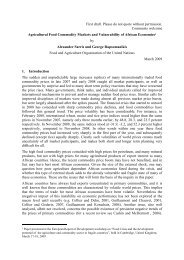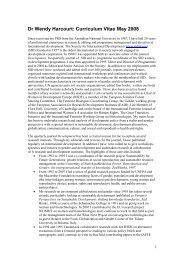Extending Health Insurance: Effects of the National ... - ResearchGate
Extending Health Insurance: Effects of the National ... - ResearchGate
Extending Health Insurance: Effects of the National ... - ResearchGate
You also want an ePaper? Increase the reach of your titles
YUMPU automatically turns print PDFs into web optimized ePapers that Google loves.
cautions needs to be put in <strong>the</strong> interpretation <strong>of</strong> <strong>the</strong> population per health facility. Since we are<br />
concerned with <strong>the</strong> NHIS, we take into account only Government health facilities (teaching<br />
hospitals, regional hospitals, Government district hospitals, Government o<strong>the</strong>r hospitals, Polyclinic,<br />
health centres, clinics and maternity homes). We do not consider privately owned health facilities<br />
(this category also includes Christian <strong>Health</strong> Association <strong>of</strong> Ghana, Islamic associations and quasi<br />
Government facilities). What we observe is a dramatic picture in terms <strong>of</strong> availability <strong>of</strong> public<br />
health facilities, not only in <strong>the</strong> most deprived regions but also in <strong>the</strong> wealthiest regions, Greater<br />
Accra, and Volta.<br />
Table 1: Distribution <strong>of</strong> <strong>Health</strong> Pr<strong>of</strong>essionals and Government Facilities in 2003 and 2008.<br />
Region Population per doctor Population per nurse Population per health facility<br />
2003 2008 2003 2008 2004 2007<br />
Ashanti 13,494 9,537 2,243 1,336 24,011 26,856<br />
Brong Ahafo 40,729 21,475 2,879 1,140 14,521 14,883<br />
Central 36,877 26,140 1,713 895 15,745 15,235<br />
Eastern 33,279 16,132 1,331 959 9,726 10,413<br />
Greater Accra 5,604 5,103 917 881 47,942 59,508<br />
Nor<strong>the</strong>n 73,262 50,751 2,380 1,534 15,175 15,893<br />
Upper East 32,786 35,010 2,027 956 9,243 8,713<br />
Upper West 50,541 47,932 1,860 870 8,567 6,299<br />
Volta 33,930 26,538 1,440 892 6,366 8,329<br />
Western 35,255 33,187 2,309 1,413 16,052 14,542<br />
<strong>National</strong> 16,759 12,713 1,649 1,079 14,614 15,600<br />
Souces: Ghana <strong>Health</strong> Service (2009), “2009 GHS Annual Report”, Ghana <strong>Health</strong> Service (2008), "The<br />
<strong>Health</strong> Sector in Ghana: Facts and Figures"; Ghana <strong>Health</strong> Service (2005), "Facts and Figures".<br />
3 Data<br />
3.1 Data Description<br />
We use nationally-representative household data from <strong>the</strong> 2008 Demographic and <strong>Health</strong> Surveys<br />
(DHS). 4 The surveys are designed to provide information to monitor <strong>the</strong> population and health<br />
situation in Ghana. More specifically, <strong>the</strong> data include information on respondent’s background,<br />
health, reproduction and contraception, fertility preferences, husband background and woman’s<br />
work (Ghana Statistical Service, 2009).<br />
4 The 2008 Ghana DHS is <strong>the</strong> most recent <strong>of</strong> <strong>the</strong> five surveys undertaken in Ghana since 1988 (1988, 1993, 1998, 2003,<br />
2008).<br />
8
















